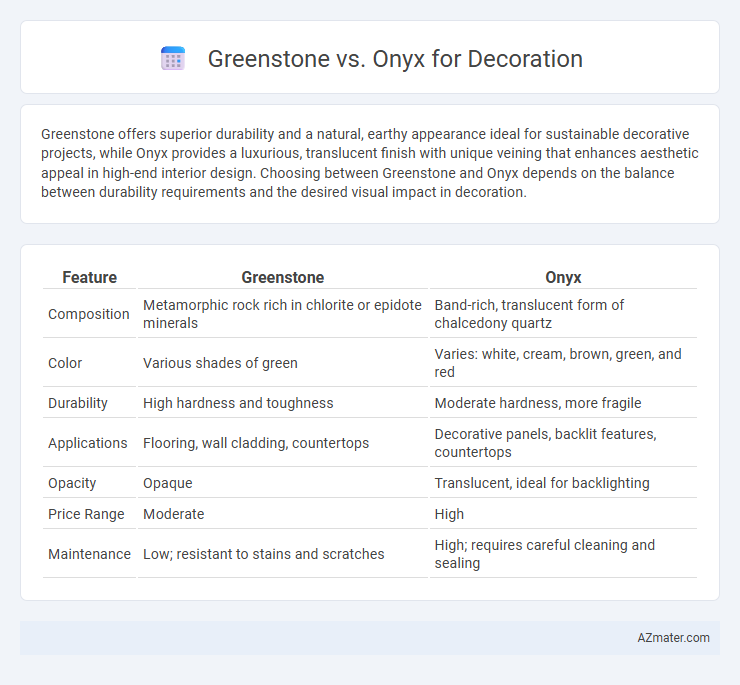Greenstone offers superior durability and a natural, earthy appearance ideal for sustainable decorative projects, while Onyx provides a luxurious, translucent finish with unique veining that enhances aesthetic appeal in high-end interior design. Choosing between Greenstone and Onyx depends on the balance between durability requirements and the desired visual impact in decoration.
Table of Comparison
| Feature | Greenstone | Onyx |
|---|---|---|
| Composition | Metamorphic rock rich in chlorite or epidote minerals | Band-rich, translucent form of chalcedony quartz |
| Color | Various shades of green | Varies: white, cream, brown, green, and red |
| Durability | High hardness and toughness | Moderate hardness, more fragile |
| Applications | Flooring, wall cladding, countertops | Decorative panels, backlit features, countertops |
| Opacity | Opaque | Translucent, ideal for backlighting |
| Price Range | Moderate | High |
| Maintenance | Low; resistant to stains and scratches | High; requires careful cleaning and sealing |
Introduction to Greenstone and Onyx
Greenstone, a durable metamorphic rock with a rich green hue, is prized for its unique texture and resilience, making it ideal for decorative applications such as countertops and flooring. Onyx, known for its translucent quality and striking veining, offers a luxurious aesthetic that enhances interior spaces with its natural patterns and vibrant color variations. Both stones serve distinct decorative purposes, with Greenstone favored for robustness and Onyx for its elegant visual appeal.
Geological Origins and Formation
Greenstone, primarily formed from metamorphosed basaltic rocks in ancient volcanic regions, exhibits a dense, fine-grained texture ideal for decorative uses. Onyx, a variety of chalcedony formed through the deposition of silica in cold water solutions within limestone caves, displays distinctive parallel banding and translucency that enhance its aesthetic appeal. The contrasting geological origins--metamorphic for greenstone and sedimentary for onyx--result in unique visual and textural qualities that influence their selection in interior decoration.
Visual Characteristics and Color Variations
Greenstone offers a variety of rich green hues with natural mottled patterns that create an earthy, organic aesthetic ideal for rustic and natural-themed decorations. Onyx features striking translucency and vibrant color variations, including creamy whites, deep browns, and fiery oranges, making it a popular choice for luxurious and dramatic interior accents. The smooth, polished surface of onyx enhances its light-reflecting properties, while greenstone's matte or slightly textured finish provides a more subdued, natural appearance.
Durability and Longevity in Decorative Use
Greenstone offers superior durability with its dense, fine-grained structure that resists scratches and environmental wear, making it ideal for long-lasting decorative applications. Onyx provides a unique translucent beauty but is softer and more prone to chipping and surface damage, requiring careful placement and maintenance. For longevity in decorative use, Greenstone outperforms Onyx due to its robust nature and lower susceptibility to damage over time.
Popular Applications in Interior Design
Greenstone and Onyx are both popular choices in interior design due to their unique visual appeal and durability. Greenstone, often used for flooring, countertops, and accent walls, offers a natural, earthy aesthetic with its rich green hues and subtle veining, making it ideal for creating calming, nature-inspired spaces. Onyx, prized for its translucency and striking patterns, is frequently applied in backlit features, countertops, and decorative panels, adding a luxurious and dramatic element to modern and classic interiors.
Maintenance and Care Requirements
Greenstone requires regular sealing to prevent staining and maintain its polished appearance, as it is more porous compared to Onyx. Onyx demands delicate cleaning with pH-neutral products due to its softer nature and susceptibility to etching and scratches. Both materials benefit from prompt spill cleanup and avoiding abrasive tools to preserve their aesthetic and structural integrity.
Cost Comparison and Market Availability
Greenstone offers a more affordable option compared to Onyx, making it a popular choice for budget-conscious decorators. Onyx, prized for its translucency and luxurious appearance, commands higher prices and is often less accessible in the mass market. Market availability favors Greenstone due to its wider distribution and abundance in natural reserves, while Onyx remains limited and primarily sourced for premium projects.
Environmental Impact and Sustainability
Greenstone offers a significant environmental advantage over onyx due to its natural abundance and minimal processing requirements, reducing carbon emissions and resource depletion. Onyx extraction typically involves intensive quarrying and chemical treatments that contribute to habitat disruption and higher energy consumption. Choosing greenstone for decoration aligns with sustainable design principles by promoting eco-friendly sourcing and lower environmental impact throughout the product lifecycle.
Design Trends and Aesthetic Appeal
Greenstone offers a vibrant, natural aesthetic with its rich, earthy hues and organic patterns, making it ideal for contemporary and eco-inspired design trends. Onyx, prized for its translucent quality and dramatic veining, creates a luxurious and sophisticated ambiance, often used in high-end installations and statement pieces. Both materials enhance interior spaces by combining unique textures with striking visual impact, catering to diverse stylistic preferences in modern decor.
Choosing Between Greenstone and Onyx for Your Space
Greenstone offers unique earthy tones and robust durability, making it ideal for rustic or natural-themed decor, while onyx stands out with its translucent layers and vibrant colors, perfect for luxurious and dramatic spaces. Selecting between greenstone and onyx depends on desired aesthetics and functional requirements; greenstone suits high-traffic areas due to its hardness, whereas onyx, being softer and more fragile, works best in low-traffic accent features. Consider the lighting effects, maintenance needs, and overall ambiance to determine which stone complements your space's design vision effectively.

Infographic: Greenstone vs Onyx for Decoration
 azmater.com
azmater.com